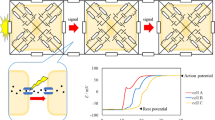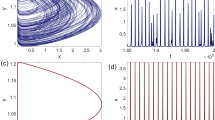Abstract
We show that action potentials in the Hodgkin-Huxley neuron model result from a type I intermittency phenomenon that occurs in the proximity of a saddle-node bifurcation of limit cycles. For the Hodgkin-Huxley spatially extended model, describing propagation of action potential along axons, we show the existence of type I intermittency and a new type of chaotic intermittency, as well as space propagating regular and chaotic diffusion waves. Chaotic intermittency occurs in the transition from a turbulent regime to the resting regime of the transmembrane potential and is characterised by the existence of a sequence of action potential spikes occurring at irregular time intervals.










Similar content being viewed by others
References
Bianchi, D., Marasco, A., Limongiello, A., Marchetti, C., Marie, H., Tirozzi, B., & Migliore, M (2012). On the mechanisms underlying the depolarization block in the spiking dynamics of CA1 pyramidal neurons. Journal of Computational Neuroscience, 33(2), 207–225.
Dias de Deus, J., Dilão, R., & Noronha da Costa, A. (1984). Intermittency and sequences of periodic regions in one dimensional maps of the interval. Physics Letters A, 101, 459–463.
Dilão, R. (2005). Turing instabilities and patterns near a hopf bifurcation. Applied Mathematics and Computation, 164, 391–414.
Dilão, R., & Sainhas, J. (1998). Validation and calibration of models for Reaction-Diffusion systems. International Journal of Bifurcation and Chaos, 8, 1163–1182.
Doedel, E., Keller, H.B., & Kernévez, J.P. (1991). Numerical analysis and control of bifurcation problems I. International Journal of Bifurcation and Chaos, 1, 493–520.
Ermentrout, B. (2002). Simulating, analyzing and animating dynamical systems: a guide to XPPAUT for researchers and students. Philadelphia, USA: SIAM.
Ermentrout, G.B., & Terman, D.H. (2010). Mathematical foundations of neuroscience. Springer.
Guckenheimer, J., & Holmes, P. (2002). Nonlinear oscillations, dynamical systems, and bifurcations of vector fields. springer.
Guckenheimer, J., & Oliva, R.A. (2002). Chaos in the Hodgkin-Huxley model. SIAM Journal on Applied Dynamical Systems, 1, 105–114.
Hassard, B. (1978). Bifurcation of periodic solutions of the Hodgkin-Huxley model for the squid giant axon. Journal of Theoretical Biology, 71, 401–420.
Hodgkin, A.L., & Huxley, A.F. (1952a). A quantitative description of membrane current and its application to conduction and excitation in nerve. The Journal of Physiology, 117, 500–544.
Hodgkin, A.L., & Huxley, A.F. (1952b). The components of membrane conductance in the giant axon of Loligo. The Journal of Physiology, 116, 473–496.
Izhikevich, E.M. (2007). Dynamical systems in neuroscience. MIT press.
Keener, J.P., & Sneyd, J. (1998). Mathematical physiology. Springer.
Kuznetsov, Y.A. (2004). Elements of applied bifurcation theory, 3rd edn. Berlin: Springer.
Pomeau, Y., & Manneville, P. (1980). Intermittent transition to turbulence in dissipative dynamical systems. Communications in Mathematical Physics, 74, 189–197.
Rae-Grant, A.D., & Kim, Y.W. (1994). Type III intermittency: a nonlinear dynamic model of EEG burst suppression. Electroencephalography and clinical Neurophysiology, 90, 17–23.
Rinzel, J., & Miller, R.N. (1980). Numerical calculation of stable and unstable periodic solutions to the Hodgkin-Huxley equations. Mathematical Biosciences, 49, 27–59.
Velazquez, J.L.P., Khosravani, H., Lozano, A., Bardakjian, B.L., Carlen, P.L., & Wennberg, R. (1999). Type III intermittency in human partial epilepsy. European Journal of Neuroscience, 11, 2571–2576.
Acknowledgements
One of the authors (RD) would like to thank IHÉS for its hospitality and Simons Foundation for support. We would also like to thank the anonymous reviewers of this paper for their comments.
Author information
Authors and Affiliations
Corresponding author
Ethics declarations
Conflict of interests
The authors declare that they have no conflict of interest.
Competing interests
The authors declare that they have no competing interests.
Additional information
Action Editor: Alain Destexhe
Appendix: The Bautin bifurcation normal form and the Hodgkin-Huxley equation
Appendix: The Bautin bifurcation normal form and the Hodgkin-Huxley equation
The normal form of the Bautin bifurcation in polar coordinates is Kuznetsov (2004)
where β 1 and β 2 are real parameters.
One of the features of the normal form Eq. (6) of the Bautin bifurcation is the existence of a SNLC bifurcation, a subcritical and a supercritical Hopf bifurcations, when the parameters β 1 and β 2 are varied. As it is shown numerically in Fig. 2, these features are present in the Hodgkin-Huxley model Eq. (1), when the parameter i is varied.
To show that the bifurcation behaviour of the diffusion free Hodgkin-Huxley Eqs. (1)–(2), is well described by the bifurcation behaviour of Eq. (6), we take the new parameters \(\rho =\sqrt {{\beta _{1}^{2}}+{\beta _{2}^{2}}}\) and θ = arctan (−β 2/β 1). The bifurcation diagram of fixed points and limit cycles as a function of θ and for ρ = 1 is presented in Fig. 11.
Bifurcation diagram of Eq. (6) as a function of θ = arctan(−β 2/β 1), for ρ = 1. The maximum values of the radial coordinate r for the stable and unstable limit cycles are represented, along with its unique fixed point r ∗ = 0. Dashed lines indicate unstable limit sets. For other values of ρ, the bifurcation diagram is similar
We note that the normal form of the Bautin bifurcation is unfolded as a two-dimensional dynamical system, whereas the diffusion free Hodgkin-Huxley equations define a four-dimensional vector field. This is due to the fact that the fixed point of Eq. (1) has a two-dimensional stable manifold, and the limit sets or attractors of the diffusion free Hodgkin-Huxley equations live in a two-dimensional space embedded in the four-dimensional phase space. All the analyses we have done show that the intermittency phenomena found in Eq. (1) are compatible with the intermittency phenomena and the bifurcation behaviour of the normal form of the Bautin bifurcation, near a SNLC bifurcation.
1.1 Intermittency near a SNLC bifurcation
A simple analysis shows that, if β 2 > 0 and β 1 < 0, there is a saddle node bifurcation in the radial variable r, which corresponds to a SNLC bifurcation in the cartesian coordinates. The codimension 2 SLNC bifurcation occurs for \(\beta _{1}=\beta _{1}^{*}=-{\beta _{2}^{2}}/4\) and a limit cycle is created with radial coordinate \(r^{*}=\sqrt {\beta _{2}/2}\). We take now the new parameter ε defined by
For β 2 > 0, the system of Eq. (6) has a SNLC bifurcation for ε = 0. If ε > 0, the system of Eq. (6) has no limit cycles and, if ε < 0, the system of Eq. (6) has two limit cycles with radial coordinates \(r_{\text {s}}=\sqrt {(\beta _{2}+2\sqrt {-\varepsilon })/2}\) and \(r_{\text {u}}=\sqrt {(\beta _{2}-2\sqrt {-\varepsilon })/2}\), where the subscripts “s” and “u” stand for stable and unstable, respectively.
Along any line β 2 = constant with β 2 > 0, for ε < 0, the asymptotic solutions of Eq. (6) with initial condition r 0 > r s converge to a stable limit cycle. For ε > 0 but close to zero, the graph of y = f(r) has a local maximum near \(r_{max}=\sqrt {\beta _{2}/2}\) which is very close to the line y = 0. For initial conditions r 0 > r s and by the continuity of the solutions of the differential equation in order to ε, the radial solution of Eq. (6) will be near r = r m a x for a long interval of time. This interval of time goes to infinity, as ε → 0. So, during this period of time, the solution of the differential equation will resemble the solution along a limit cycle that does not exist. This is the phenomenon of type I intermittency, Pomeau and Manneville (1980) and Guckenheimer and Holmes (2002).
As a function of ε, we estimate the time of permanence of the solution of Eq. (6) near the point \(r_{max}=\sqrt {\beta _{2}/2}\), the radius of the limit cycle at bifurcation. As this analysis is local, we take u = r − r m a x and, by Eq. (7), the first equation in Eq. (6) is rewritten as
In this new coordinate, the SNLC bifurcation occurs for ε = 0 and the limit cycle has u-radial coordinate u = r − r m a x = 0.
For an initial condition u(0) = d > 0, the time of permanence of the solutions of Eq. (8) in the interval [−d, d] is
In the limit ε → 0, arctan(.) → π/2 and the previous expression becomes
Thus, we have proved that in the left vicinity of a codimension 2 SNLC bifurcation, the orbits follow a trajectory resembling a limit cycle oscillation during a time that goes to infinity as the bifurcation is approached.
1.2 Stability of the steady state of the HH equations
Here, we analyse the stability of the homogeneous stable state p ∗(0) = (V ∗(0), n ∗(0), m ∗(0), h ∗(0)) of the second and third equations in Eq. (4), with the boundary conditions Eq. (5).
Due to the zero flux boundary conditions Eq. (5), the solutions of the second and third equations in Eq. (4) can be written in the form
where a k (t), b k (t), c k (t) and d k (t) are time dependent unknown functions of time, and V (x, t), n(x, t), m(x, t), h(x, t) ∈ L 2([0, L]), for every t ≥ 0. As usual, a k (t), b k (t), c k (t) and d k (t) are the k-eigenmode solutions of the extended HH equations. To analyse the stability of p ∗(0), following (Dilão 2005), we introduce (11) into the first equation in (4) and, up to first order in the phase space variables we obtain
for every k ≥ 1 and the matrix is evaluated at p ∗(0). If, for every k > 1, the real parts of the eigenvalues of the jacobian matrix in Eq. (12) are negative, the homogeneous spatial solution (V (x, t), n(x, t)) = p ∗(0) of the first and third equations in Eq. (4) is stable. Due to the complex form of the vector field components, the jacobian matrix is difficult to calculate. So, we have analysed numerically the real part of its eigenvalues, for a large range of the index k. For values of the eigenmode number k, up to k = 2 000, and for D ∈ [10−6, 10], all the eigenvalues of the matrix in Eq. (12) have negative real parts, implying that the homogeneous steady state of the extended HH equation is stable.
Rights and permissions
About this article
Cite this article
Cano, G., Dilão, R. Intermittency in the Hodgkin-Huxley model. J Comput Neurosci 43, 115–125 (2017). https://doi.org/10.1007/s10827-017-0653-9
Received:
Revised:
Accepted:
Published:
Issue Date:
DOI: https://doi.org/10.1007/s10827-017-0653-9





